The proper use of syringes and needles becomes second nature in today’s cattle production, whether it’s for treating, vaccinating, flushing, aspirating or applying local anesthetic.
We all have our preferences when grabbing syringes and needles.
As well, we don’t want to leave needles in animals, and we don’t want to cause more pain than necessary by using improper needles.
There are no concrete rules.
But there are principles that make the job easier, save time, deliver products correctly and are less hard on livestock.
Read Also

Manitoba extends Crown land rent freeze
Manitoba government links the continued rental rate freeze on grazing and forage leases to economic and environmental challenges facing the industry
Choosing a needle size and length is the first decision to make.
Most products are given subcutaneously, which can be accomplished with at most a one-inch needle and often with a three-quarter inch one.
The gauge or bore of the needles will depend on the viscosity of the product and the volume to be injected.
More viscous products such as some antibiotics require a 16-gauge needle, while more watery products such as selenium can be given with an 18- to 20-gauge needle.
The higher the gauge or number, the smaller the bore of needle.
Cows and yearlings generally receive 18- to 16-gauge needles, while with calves we pretty much stick to 18- to 20-gauge needles.
Smaller bores create smaller holes, which should generate less pain.
A 1 1/2 inch needle is needed for intramuscular shots in cows for products such as scours vaccines and vitamins A and D and some of the older antibiotics. Strength is also important, so an 18- or 16-gauge needle is common for the more viscous products.
Always use disposable needles that are sharper, have a thinner wall and cause less damage than the older steel needles. Make sure they have metal hubs.
We often use the one-handed technique when giving subcutaneous shots, which involves inserting the needle at an angle into the pocket under the skin without tenting it. We can actually feel the needle drop down into the subcutaneous space.
This technique keeps our free hand away from the sharp needle and prevents injuries around chutes when cattle lurch forward or backward and pinch our hands.
It is important during mass processing and vaccinating to use automatic guns that can set the exact dosage. They are accurate in delivery and can be cleaned easily.
It is best to use warm water when finishing and disassemble the syringe if necessary.
However, avoid cleansing agents, especially if using the syringes right away. Veterinary clinics will autoclave syringes between herds.
Disposable syringes are the other option, but they are best used when inserting the needle and then attaching the syringe.
Otherwise, the plastic syringes will often break at the hub. Believe me, I know this from experience.
The last thing we want is a needle left in the hide, so proper restraint, such as in a squeeze chute, is necessary in anything bigger than newborn calves.
As well, always visually check to make sure the needle is still on the end of the syringe when the injection is complete.
We always want to use new needles when giving intravenous shots or between groups of animals.
As well, there are instances, such as with bovine leucosis, when these cattle should be segregated and needled last so that the disease isn’t transmitted in the blood.
Changing needles every 10 or so animals when vaccinating is a necessary habit to acquire. Needles should also be changed when they are dulled, burred, bent or soiled.
Use a new needle to pull out of the bottle of vaccine or antibiotic.
As well, make sure to always have a sharps container available. A one-gallon plastic jug properly labelled for sharps will last a farm for years.
Use the needle cap to remove the needle. I bend them and twist them off or have a pair of pliers handy.
Needles can be bought in packages of 100, so don’t hesitate to have lots around with several gauges and various lengths from which to choose.
Most products can now be given subcutaneously using a one handed technique.
However, producers who give intramuscular shots should ideally put in the needle first and watch for blood.
Some intramuscular injections such as penicillin can cause an allergic reaction if inadvertently injected into a vein.
Watch the labels to ensure that the product is given where indicated. More products are now labelled for subcutaneous use, which contributes to better meat quality.
Taking care of needle selection will help producers do a much better job administering vaccines and antibiotics by reducing swellings, abscesses and scarring.
Going subcutaneous whenever it is allowed prevents muscle damage.
Needle use is starting to decline as progress is made in intranasal vaccines, products given orally or topically and needleless vaccinators.
Always have epinephrine close by in case of an allergic reaction, which is possible with any product that is injected.















